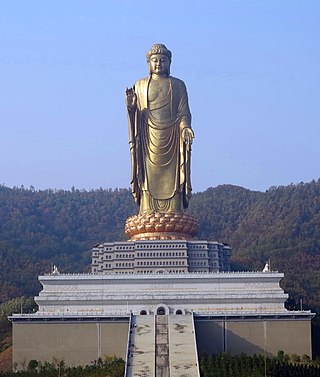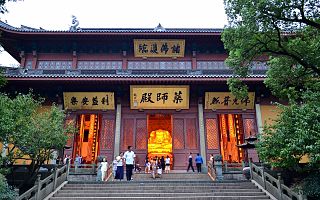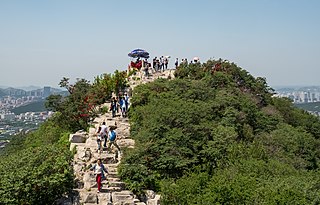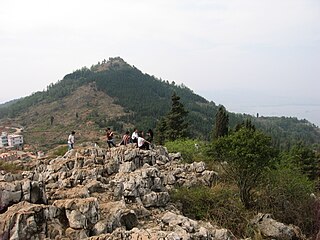
The Mogao Caves, also known as the Thousand Buddha Grottoes or Caves of the Thousand Buddhas, form a system of 500 temples 25 km (16 mi) southeast of the center of Dunhuang, an oasis located at a religious and cultural crossroads on the Silk Road, in Gansu province, China. The caves may also be known as the Dunhuang Caves; however, this term is also used as a collective term to include other Buddhist cave sites in and around the Dunhuang area, such as the Western Thousand Buddha Caves, Eastern Thousand Buddha Caves, Yulin Caves, and Five Temple Caves. The caves contain some of the finest examples of Buddhist art spanning a period of 2,000 years.

Vairocana is a cosmic buddha from Mahayana and Vajrayana Buddhism. Vairocana is often interpreted, in texts like the Avatamsaka Sutra, as the dharmakāya of the historical Gautama Buddha. In East Asian Buddhism, Vairocana is also seen as the embodiment of the Buddhist concept of śūnyatā. In the conception of the 5 Jinas of Mahayana and Vajrayana Buddhism, Vairocana is at the centre and is considered a Primordial Buddha.
A Wisdom King is a type of wrathful deity in East Asian Buddhism.

The Longmen Grottoes or Longmen Caves are some of the finest examples of Chinese Buddhist art. Housing tens of thousands of statues of Shakyamuni Buddha and his disciples, they are located 12 kilometres (7.5 mi) south of present-day Luoyang in Henan province, China. The images, many once painted, were carved as outside rock reliefs and inside artificial caves excavated from the limestone cliffs of the Xiangshan (香山) and Longmenshan, running east and west. The Yi River flows northward between them and the area used to be called Yique. The alternative name of "Dragon's Gate Grottoes" derives from the resemblance of the two hills that check the flow of the Yi River to the typical "Chinese gate towers" that once marked the entrance to Luoyang from the south. There are as many as 100,000 statues within the 2,345 caves, ranging from 1 inch (25 mm) to 57 feet (17 m) in height. The area also contains nearly 2,500 stelae and inscriptions, hence the name "Forest of Ancient Stelae", as well as over sixty Buddhist pagodas. Situated in a scenic natural environment, the caves were dug from a 1 kilometre (0.62 mi) stretch of cliff running along both banks of the river. 30% date from the Northern Wei and 60% from the Tang dynasty, caves from other periods accounting for less than 10% of the total. Starting with the Northern Wei dynasty in 493 AD, patrons and donors included emperors, Wu Zetian, members of the royal family, other rich families, generals, and religious groups.

The Yungang Grottoes, formerly the Wuzhoushan Grottoes, are ancient Chinese Buddhist temple grottoes built during the Northern Wei dynasty near the city of Datong, then called Pingcheng, in the province of Shanxi. They are excellent examples of rock-cut architecture and one of the three most famous ancient Buddhist sculptural sites of China. The others are Longmen and Mogao.

Lingyin Temple is a prominent Chan Buddhist temple near Hangzhou that is renowned for its many pagodas and grottos. Its name is commonly and literally translated into English as Temple of the Soul's Retreat.

The Bingling Temple is a series of grottoes filled with Buddhist sculpture carved into natural caves and caverns in a canyon along the Yellow River. It lies just north of where the Yellow River empties into the Liujiaxia Reservoir. Administratively, the site is in Yongjing County of Linxia Hui Autonomous Prefecture in Gansu province, some 100 km (62 mi) southeast of Lanzhou. This temple, along with other sites along the Silk Road, was inscribed in 2014 on the UNESCO World Heritage List as the Silk Roads: the Routes Network of Chang'an-Tianshan Corridor World Heritage Site.

Buddhism's rich history spans over 2,500 years, originating from the Indian subcontinent in the 2nd century AD. Teachings of the Buddha were introduced over time, as a response to brahmanical teachings. Buddhism relies on the continual analysis of the self, rather than being defined by a ritualistic system, or singular set of beliefs. The intersections of Buddhism with other Eastern religions, such as Taoism, Shinto, Hinduism, and Bon illustrate the interconnected ideologies that interplay along the path of enlightenment. Buddhism and eastern religions tend to share the world-view that all sentient beings are subject to a cycle of rebirth that has no clear end.

The Thousand Buddha Mountain is a hill located about 2.5 kilometers southeast of the city of Jinan, the capital of Shandong Province, China. It covers 1.518 square kilometers and has a peak of 285 meters (935 ft) above sea level. It is renowned for its numerous Buddha images which have been carved out of the hill's rock faces or free-standing structures erect since the times of the Sui dynasty (581–618) and its Xingguochan Temple. It is considered one of the "Three Greatest Attractions in Jinan" together with Baotu Spring and Daming Lake. It is also one of the 4A-rated Tourist attractions in China. Thousand Buddha Mountain is opened up as a public park in 1959, rated as AAAA-rated Tourist Attractions of China in 2005, and rated as National Park of China in March 2017.

Taoism or "Do" is thought to be the earliest state philosophy for the Korean people. However, its influence waned with the introduction of Buddhism during the Goryeo kingdom as the national religion and the dominance of neo-Confucianism during the Joseon dynasty. Despite its diminished influence during those periods, it permeated all strata of the Korean populace, integrating with its native animism as well as Buddhist and Confucian institutions, temples, and ceremonies. The Taoist practice in Korea developed, somewhat in contrast to China, as an esoteric meditative practice in the mountains taught by the "mountain masters" or "mountain sages".

Buddhist art is visual art produced in the context of Buddhism. It includes depictions of Gautama Buddha and other Buddhas and bodhisattvas, notable Buddhist figures both historical and mythical, narrative scenes from their lives, mandalas, and physical objects associated with Buddhist practice, such as vajras, bells, stupas and Buddhist temple architecture. Buddhist art originated in the north of the Indian subcontinent, in modern India, Pakistan and Afghanistan, with the earliest survivals dating from a few centuries after the historical life of Siddhartha Gautama from the 6th to 5th century BCE.

The Thousand-Buddha Cliff is a historical site of mostly Tang dynasty rock carvings in central Shandong Province, China. Along a cliff face of 63 meters length, over 210 statues and 43 inscriptions have been reported. Most of the statues were carved during 618–684.

The Western Mountains or Western Hills are a scenic mountain area located 12 km to the west of Kunming, Yunnan, China. They are formed by the Huating, Taihua and Luohan mountain ranges rising above the eastern and northern banks of Dianchi Lake.
Buddha cave may refer to many caves in Asia which are noted for their Buddha statues:
Baodingshan is a Buddhist site in Chongqing. The site is located on a limestone outcropping at an elevation of 500 meters, fifteen kilometers north of the center of Dazu District, a market town that dates to 758 CE and the city is ringed by religious sites dating from 892 to 1249 CE. Primary construction at Baodingshan took place during the Southern Song dynasty but it remained largely unknown to the outside world until its reopening to the public in the 1980s, the earliest documented research on the site dating to 1944. The site has since been designated a World Heritage Site since 1999, falling within the collective grouping of Dazu Rock Carvings, a reference to the district in which Baodingshan is located. Dazu County covers 1400 square kilometers northwest of Chongqing on the road to Chengdu. During the Song dynasty, this area of the Chengdu plain was considered one of the wealthiest regions in China.

Chinese Buddhist sculpture has been produced throughout the history of Buddhism in China. Sculptural pieces include representations of Siddhārtha Gautama, often known as the "Enlightened One" or "Buddha", Bodhisattvas, monks and various deities. China was introduced to the teachings of Buddhism as early as the 2nd century BCE, during China's Han dynasty, becoming more established during the 2nd century CE. The earliest representations did not start as sculptures of the human form, but rather an empty seat, footprint, tree or stupa, an architectural form eventually inspiring the creation of pagodas in China.

Baoguo Temple is a Buddhist temple located on Mount Emei, in Emeishan City, Sichuan, China. It is the site of the Buddhist Association of Mount Emei. The temple mainly enshrines Buddhist Bodhisattvas as well as sages of Confucianism and deities of Taoism, which makes it a unique temple of three spiritual traditions.

Religion in the Song dynasty (960–1279) was primarily composed of three institutional religions: Confucianism, Taoism, and Buddhism, in addition to Chinese folk religion. The Song period saw the rise of Zhengyi Taoism as a state sponsored religion and a Confucian response to Taoism and Buddhism in the form of Neo-Confucianism. While Neo-Confucianism was initially treated as a heterodox teaching and proscribed, it later became the mainstream elite philosophy and the state orthodoxy in 1241.

The Andingsi Grottoes is the name given to a Buddhist site commissioned in 1132 AD containing hundreds of Bodhisattvas, Arhats, and Buddhas carved into the walls and columns of the two chambers of this small cave.




































